Innovation Theories and TerraCycle: Historical and Future Development
VerifiedAdded on 2023/01/12
|13
|3781
|44
Report
AI Summary
This report delves into the realm of innovation theories, focusing on the application of disruptive innovation. It begins with an introduction to innovation and the chosen theory, followed by a detailed explanation of disruptive innovation, including definitions, principles, and processes. The report then evaluates the benefits and limitations of this theory. The core of the report applies the chosen theory to TerraCycle, a company known for its waste management and recycling initiatives. It provides a company background, analyzes TerraCycle's historical development, and explores its business model. Furthermore, the report forecasts the future development of TerraCycle based on the chosen innovation theory, offering recommendations for future pathways. The analysis covers various aspects like waste collection, solutions, and profitable equations. The report also includes a business canvas model, offering a comprehensive understanding of TerraCycle's operations and strategic approach.
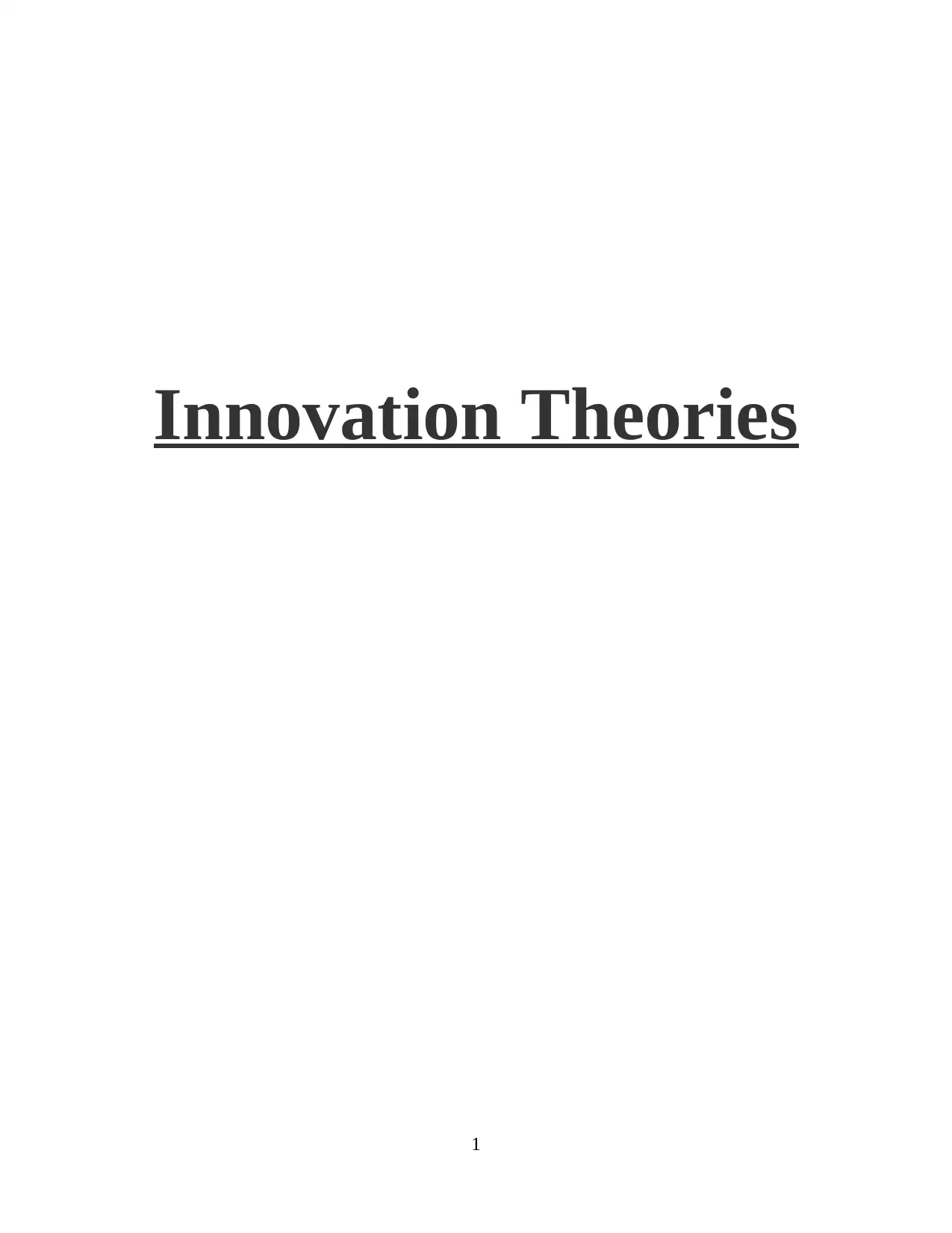
Innovation Theories
1
1
Paraphrase This Document
Need a fresh take? Get an instant paraphrase of this document with our AI Paraphraser
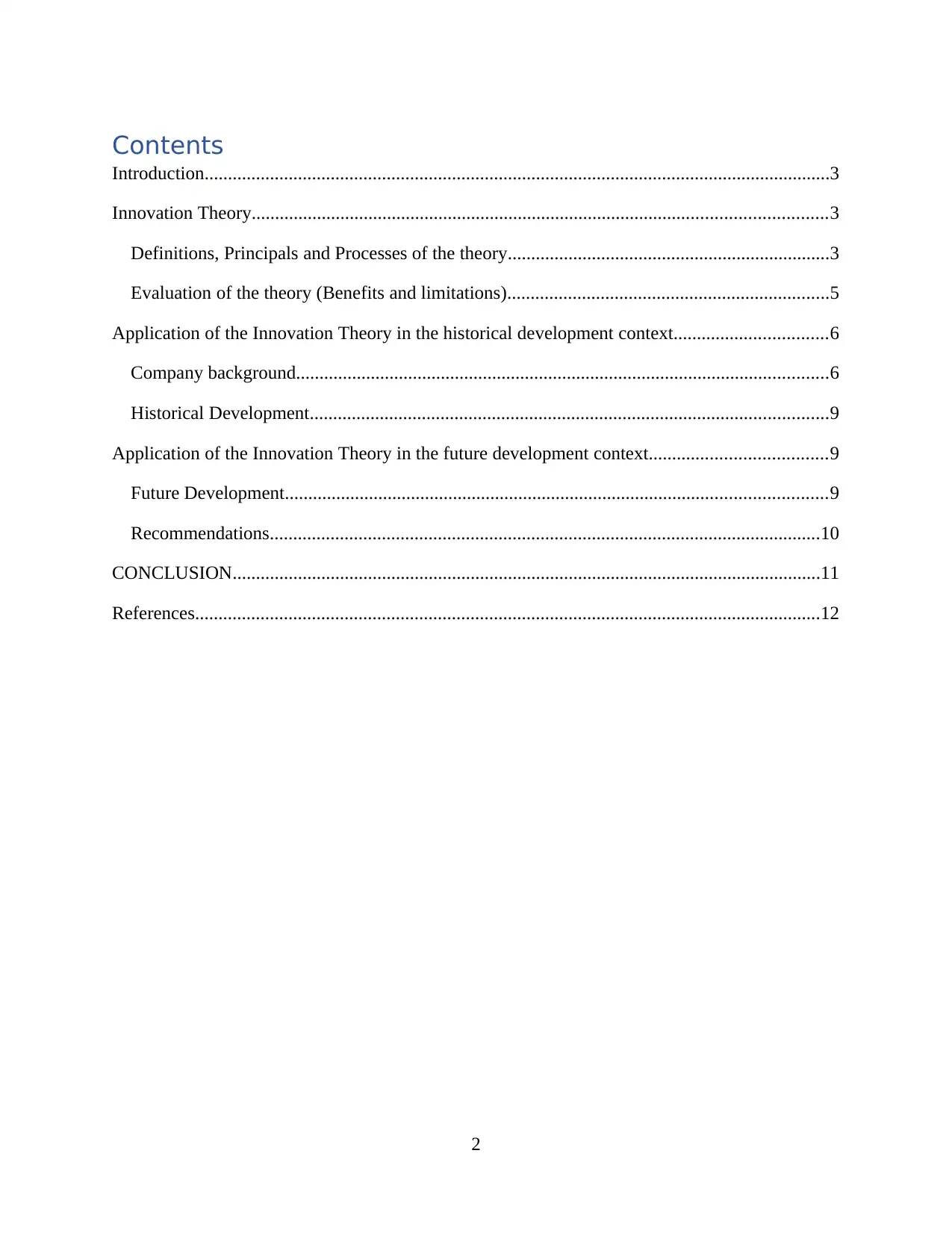
Contents
Introduction......................................................................................................................................3
Innovation Theory...........................................................................................................................3
Definitions, Principals and Processes of the theory.....................................................................3
Evaluation of the theory (Benefits and limitations).....................................................................5
Application of the Innovation Theory in the historical development context.................................6
Company background..................................................................................................................6
Historical Development...............................................................................................................9
Application of the Innovation Theory in the future development context......................................9
Future Development....................................................................................................................9
Recommendations......................................................................................................................10
CONCLUSION..............................................................................................................................11
References......................................................................................................................................12
2
Introduction......................................................................................................................................3
Innovation Theory...........................................................................................................................3
Definitions, Principals and Processes of the theory.....................................................................3
Evaluation of the theory (Benefits and limitations).....................................................................5
Application of the Innovation Theory in the historical development context.................................6
Company background..................................................................................................................6
Historical Development...............................................................................................................9
Application of the Innovation Theory in the future development context......................................9
Future Development....................................................................................................................9
Recommendations......................................................................................................................10
CONCLUSION..............................................................................................................................11
References......................................................................................................................................12
2
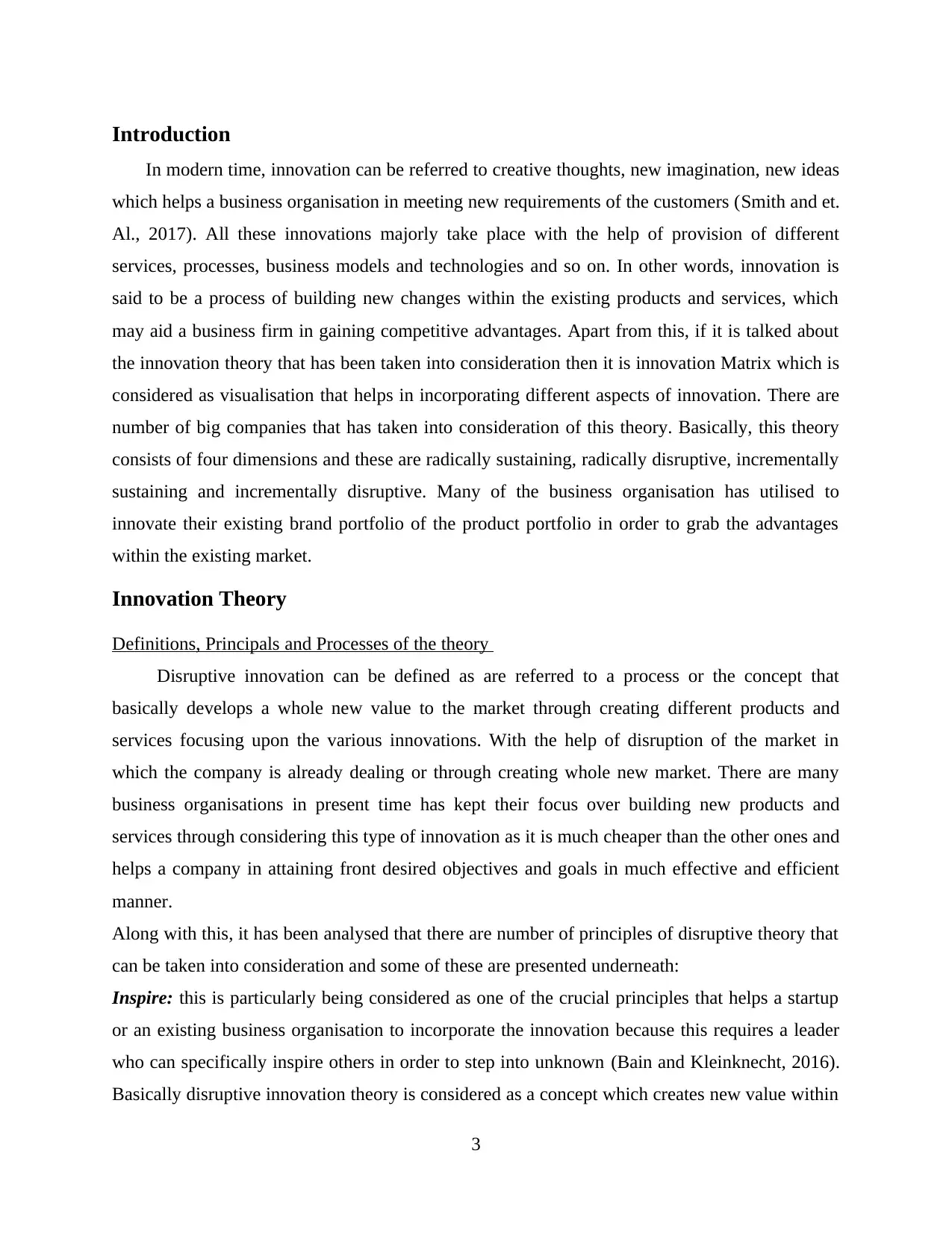
Introduction
In modern time, innovation can be referred to creative thoughts, new imagination, new ideas
which helps a business organisation in meeting new requirements of the customers (Smith and et.
Al., 2017). All these innovations majorly take place with the help of provision of different
services, processes, business models and technologies and so on. In other words, innovation is
said to be a process of building new changes within the existing products and services, which
may aid a business firm in gaining competitive advantages. Apart from this, if it is talked about
the innovation theory that has been taken into consideration then it is innovation Matrix which is
considered as visualisation that helps in incorporating different aspects of innovation. There are
number of big companies that has taken into consideration of this theory. Basically, this theory
consists of four dimensions and these are radically sustaining, radically disruptive, incrementally
sustaining and incrementally disruptive. Many of the business organisation has utilised to
innovate their existing brand portfolio of the product portfolio in order to grab the advantages
within the existing market.
Innovation Theory
Definitions, Principals and Processes of the theory
Disruptive innovation can be defined as are referred to a process or the concept that
basically develops a whole new value to the market through creating different products and
services focusing upon the various innovations. With the help of disruption of the market in
which the company is already dealing or through creating whole new market. There are many
business organisations in present time has kept their focus over building new products and
services through considering this type of innovation as it is much cheaper than the other ones and
helps a company in attaining front desired objectives and goals in much effective and efficient
manner.
Along with this, it has been analysed that there are number of principles of disruptive theory that
can be taken into consideration and some of these are presented underneath:
Inspire: this is particularly being considered as one of the crucial principles that helps a startup
or an existing business organisation to incorporate the innovation because this requires a leader
who can specifically inspire others in order to step into unknown (Bain and Kleinknecht, 2016).
Basically disruptive innovation theory is considered as a concept which creates new value within
3
In modern time, innovation can be referred to creative thoughts, new imagination, new ideas
which helps a business organisation in meeting new requirements of the customers (Smith and et.
Al., 2017). All these innovations majorly take place with the help of provision of different
services, processes, business models and technologies and so on. In other words, innovation is
said to be a process of building new changes within the existing products and services, which
may aid a business firm in gaining competitive advantages. Apart from this, if it is talked about
the innovation theory that has been taken into consideration then it is innovation Matrix which is
considered as visualisation that helps in incorporating different aspects of innovation. There are
number of big companies that has taken into consideration of this theory. Basically, this theory
consists of four dimensions and these are radically sustaining, radically disruptive, incrementally
sustaining and incrementally disruptive. Many of the business organisation has utilised to
innovate their existing brand portfolio of the product portfolio in order to grab the advantages
within the existing market.
Innovation Theory
Definitions, Principals and Processes of the theory
Disruptive innovation can be defined as are referred to a process or the concept that
basically develops a whole new value to the market through creating different products and
services focusing upon the various innovations. With the help of disruption of the market in
which the company is already dealing or through creating whole new market. There are many
business organisations in present time has kept their focus over building new products and
services through considering this type of innovation as it is much cheaper than the other ones and
helps a company in attaining front desired objectives and goals in much effective and efficient
manner.
Along with this, it has been analysed that there are number of principles of disruptive theory that
can be taken into consideration and some of these are presented underneath:
Inspire: this is particularly being considered as one of the crucial principles that helps a startup
or an existing business organisation to incorporate the innovation because this requires a leader
who can specifically inspire others in order to step into unknown (Bain and Kleinknecht, 2016).
Basically disruptive innovation theory is considered as a concept which creates new value within
3
⊘ This is a preview!⊘
Do you want full access?
Subscribe today to unlock all pages.

Trusted by 1+ million students worldwide
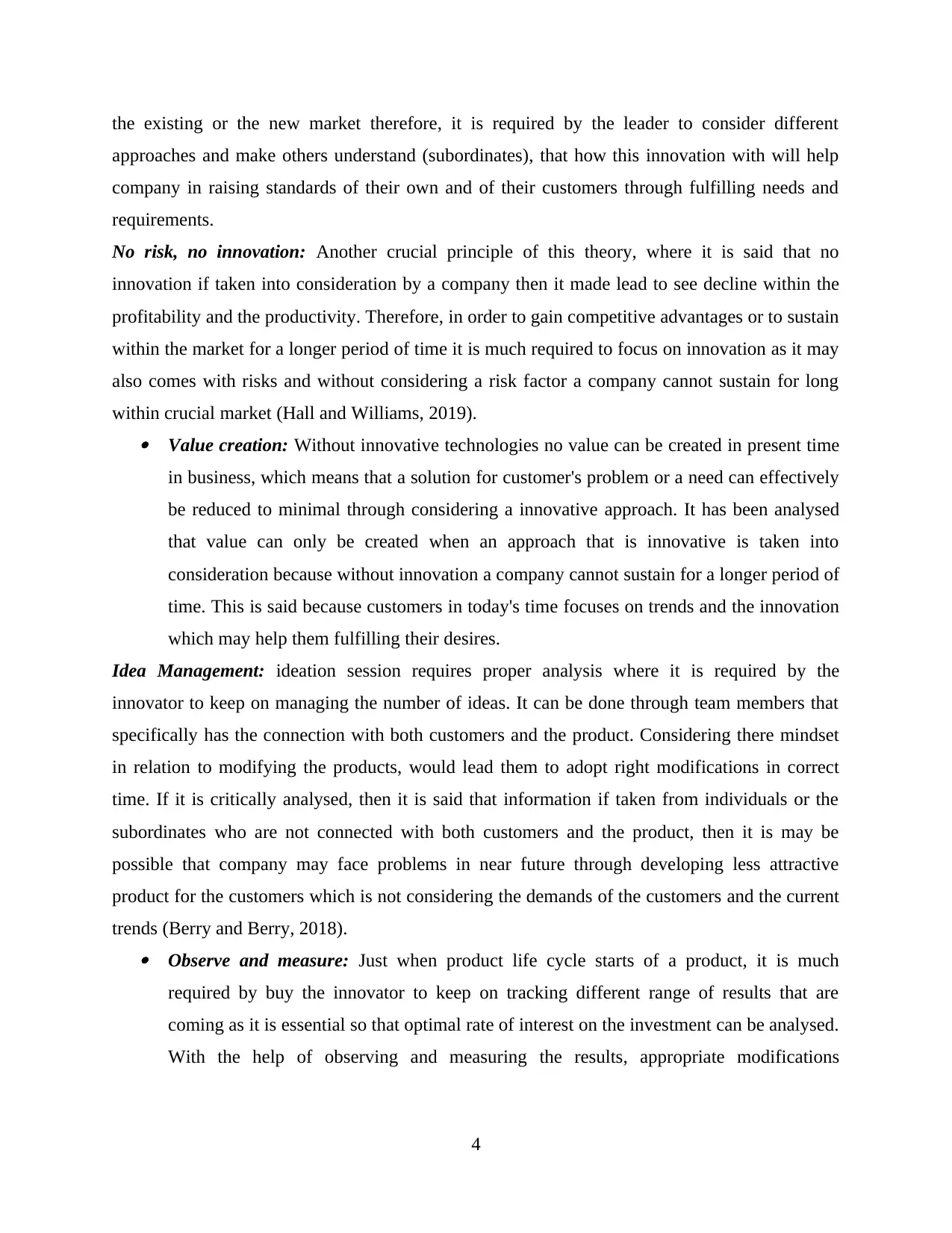
the existing or the new market therefore, it is required by the leader to consider different
approaches and make others understand (subordinates), that how this innovation with will help
company in raising standards of their own and of their customers through fulfilling needs and
requirements.
No risk, no innovation: Another crucial principle of this theory, where it is said that no
innovation if taken into consideration by a company then it made lead to see decline within the
profitability and the productivity. Therefore, in order to gain competitive advantages or to sustain
within the market for a longer period of time it is much required to focus on innovation as it may
also comes with risks and without considering a risk factor a company cannot sustain for long
within crucial market (Hall and Williams, 2019). Value creation: Without innovative technologies no value can be created in present time
in business, which means that a solution for customer's problem or a need can effectively
be reduced to minimal through considering a innovative approach. It has been analysed
that value can only be created when an approach that is innovative is taken into
consideration because without innovation a company cannot sustain for a longer period of
time. This is said because customers in today's time focuses on trends and the innovation
which may help them fulfilling their desires.
Idea Management: ideation session requires proper analysis where it is required by the
innovator to keep on managing the number of ideas. It can be done through team members that
specifically has the connection with both customers and the product. Considering there mindset
in relation to modifying the products, would lead them to adopt right modifications in correct
time. If it is critically analysed, then it is said that information if taken from individuals or the
subordinates who are not connected with both customers and the product, then it is may be
possible that company may face problems in near future through developing less attractive
product for the customers which is not considering the demands of the customers and the current
trends (Berry and Berry, 2018). Observe and measure: Just when product life cycle starts of a product, it is much
required by buy the innovator to keep on tracking different range of results that are
coming as it is essential so that optimal rate of interest on the investment can be analysed.
With the help of observing and measuring the results, appropriate modifications
4
approaches and make others understand (subordinates), that how this innovation with will help
company in raising standards of their own and of their customers through fulfilling needs and
requirements.
No risk, no innovation: Another crucial principle of this theory, where it is said that no
innovation if taken into consideration by a company then it made lead to see decline within the
profitability and the productivity. Therefore, in order to gain competitive advantages or to sustain
within the market for a longer period of time it is much required to focus on innovation as it may
also comes with risks and without considering a risk factor a company cannot sustain for long
within crucial market (Hall and Williams, 2019). Value creation: Without innovative technologies no value can be created in present time
in business, which means that a solution for customer's problem or a need can effectively
be reduced to minimal through considering a innovative approach. It has been analysed
that value can only be created when an approach that is innovative is taken into
consideration because without innovation a company cannot sustain for a longer period of
time. This is said because customers in today's time focuses on trends and the innovation
which may help them fulfilling their desires.
Idea Management: ideation session requires proper analysis where it is required by the
innovator to keep on managing the number of ideas. It can be done through team members that
specifically has the connection with both customers and the product. Considering there mindset
in relation to modifying the products, would lead them to adopt right modifications in correct
time. If it is critically analysed, then it is said that information if taken from individuals or the
subordinates who are not connected with both customers and the product, then it is may be
possible that company may face problems in near future through developing less attractive
product for the customers which is not considering the demands of the customers and the current
trends (Berry and Berry, 2018). Observe and measure: Just when product life cycle starts of a product, it is much
required by buy the innovator to keep on tracking different range of results that are
coming as it is essential so that optimal rate of interest on the investment can be analysed.
With the help of observing and measuring the results, appropriate modifications
4
Paraphrase This Document
Need a fresh take? Get an instant paraphrase of this document with our AI Paraphraser
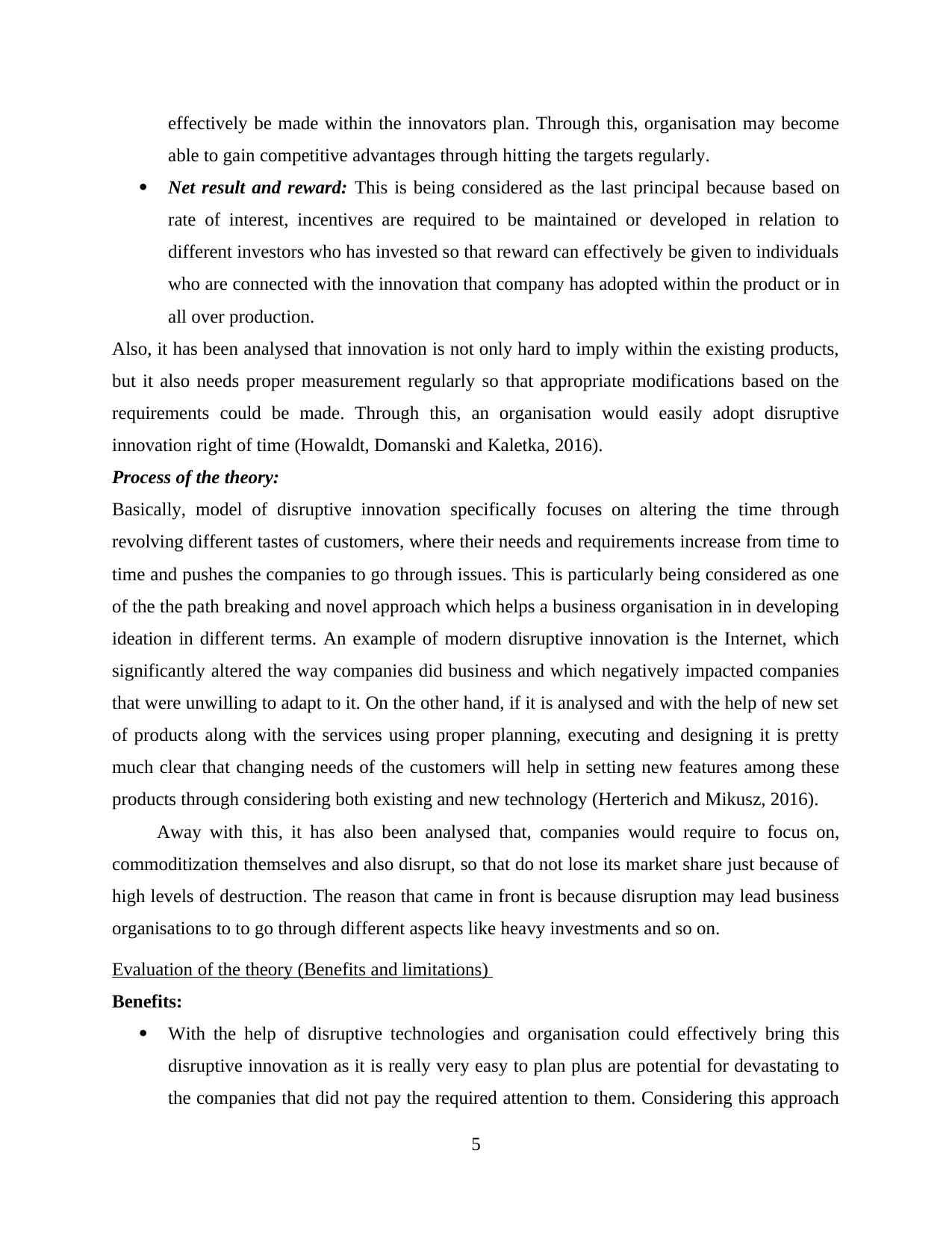
effectively be made within the innovators plan. Through this, organisation may become
able to gain competitive advantages through hitting the targets regularly.
Net result and reward: This is being considered as the last principal because based on
rate of interest, incentives are required to be maintained or developed in relation to
different investors who has invested so that reward can effectively be given to individuals
who are connected with the innovation that company has adopted within the product or in
all over production.
Also, it has been analysed that innovation is not only hard to imply within the existing products,
but it also needs proper measurement regularly so that appropriate modifications based on the
requirements could be made. Through this, an organisation would easily adopt disruptive
innovation right of time (Howaldt, Domanski and Kaletka, 2016).
Process of the theory:
Basically, model of disruptive innovation specifically focuses on altering the time through
revolving different tastes of customers, where their needs and requirements increase from time to
time and pushes the companies to go through issues. This is particularly being considered as one
of the the path breaking and novel approach which helps a business organisation in in developing
ideation in different terms. An example of modern disruptive innovation is the Internet, which
significantly altered the way companies did business and which negatively impacted companies
that were unwilling to adapt to it. On the other hand, if it is analysed and with the help of new set
of products along with the services using proper planning, executing and designing it is pretty
much clear that changing needs of the customers will help in setting new features among these
products through considering both existing and new technology (Herterich and Mikusz, 2016).
Away with this, it has also been analysed that, companies would require to focus on,
commoditization themselves and also disrupt, so that do not lose its market share just because of
high levels of destruction. The reason that came in front is because disruption may lead business
organisations to to go through different aspects like heavy investments and so on.
Evaluation of the theory (Benefits and limitations)
Benefits:
With the help of disruptive technologies and organisation could effectively bring this
disruptive innovation as it is really very easy to plan plus are potential for devastating to
the companies that did not pay the required attention to them. Considering this approach
5
able to gain competitive advantages through hitting the targets regularly.
Net result and reward: This is being considered as the last principal because based on
rate of interest, incentives are required to be maintained or developed in relation to
different investors who has invested so that reward can effectively be given to individuals
who are connected with the innovation that company has adopted within the product or in
all over production.
Also, it has been analysed that innovation is not only hard to imply within the existing products,
but it also needs proper measurement regularly so that appropriate modifications based on the
requirements could be made. Through this, an organisation would easily adopt disruptive
innovation right of time (Howaldt, Domanski and Kaletka, 2016).
Process of the theory:
Basically, model of disruptive innovation specifically focuses on altering the time through
revolving different tastes of customers, where their needs and requirements increase from time to
time and pushes the companies to go through issues. This is particularly being considered as one
of the the path breaking and novel approach which helps a business organisation in in developing
ideation in different terms. An example of modern disruptive innovation is the Internet, which
significantly altered the way companies did business and which negatively impacted companies
that were unwilling to adapt to it. On the other hand, if it is analysed and with the help of new set
of products along with the services using proper planning, executing and designing it is pretty
much clear that changing needs of the customers will help in setting new features among these
products through considering both existing and new technology (Herterich and Mikusz, 2016).
Away with this, it has also been analysed that, companies would require to focus on,
commoditization themselves and also disrupt, so that do not lose its market share just because of
high levels of destruction. The reason that came in front is because disruption may lead business
organisations to to go through different aspects like heavy investments and so on.
Evaluation of the theory (Benefits and limitations)
Benefits:
With the help of disruptive technologies and organisation could effectively bring this
disruptive innovation as it is really very easy to plan plus are potential for devastating to
the companies that did not pay the required attention to them. Considering this approach
5
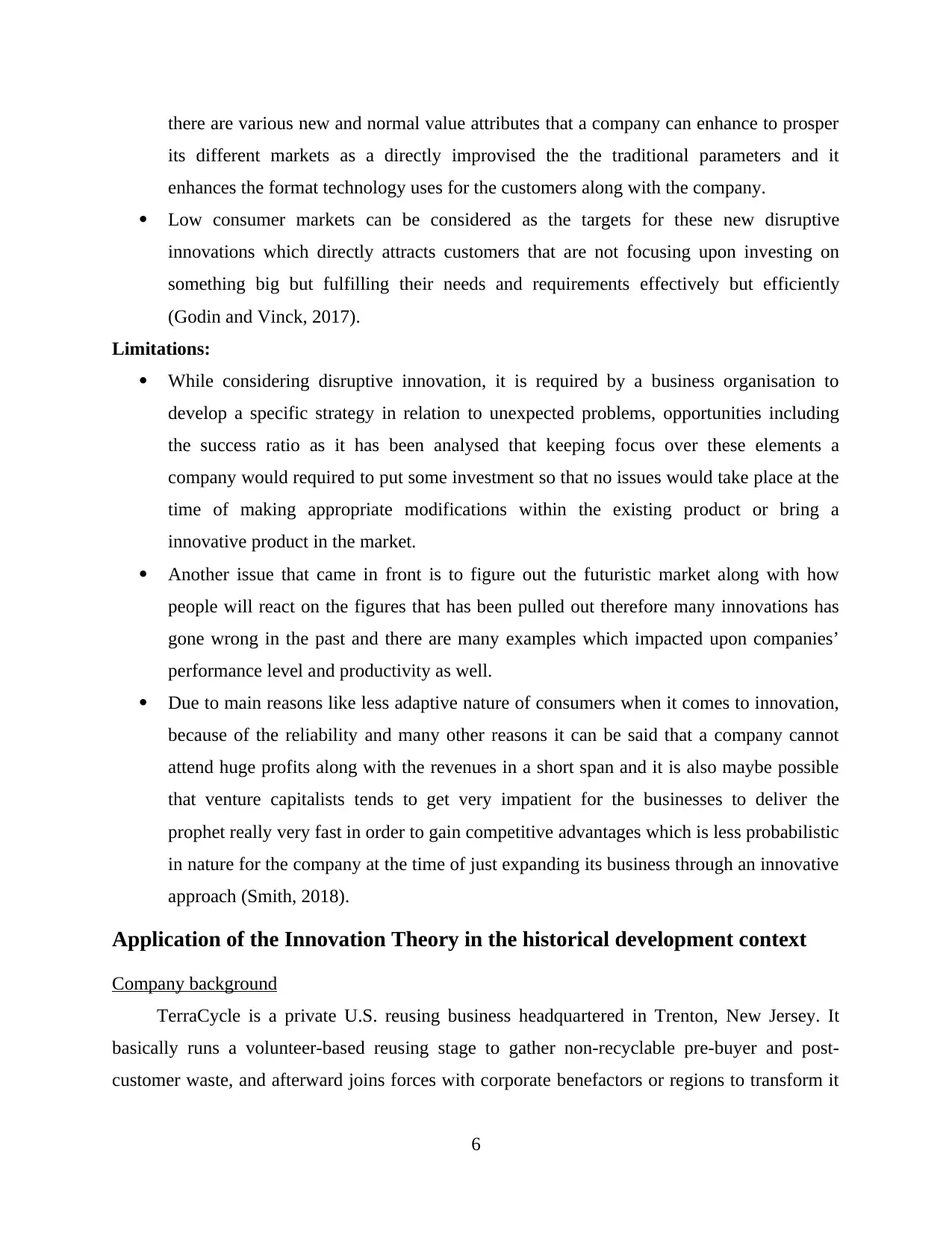
there are various new and normal value attributes that a company can enhance to prosper
its different markets as a directly improvised the the traditional parameters and it
enhances the format technology uses for the customers along with the company.
Low consumer markets can be considered as the targets for these new disruptive
innovations which directly attracts customers that are not focusing upon investing on
something big but fulfilling their needs and requirements effectively but efficiently
(Godin and Vinck, 2017).
Limitations:
While considering disruptive innovation, it is required by a business organisation to
develop a specific strategy in relation to unexpected problems, opportunities including
the success ratio as it has been analysed that keeping focus over these elements a
company would required to put some investment so that no issues would take place at the
time of making appropriate modifications within the existing product or bring a
innovative product in the market.
Another issue that came in front is to figure out the futuristic market along with how
people will react on the figures that has been pulled out therefore many innovations has
gone wrong in the past and there are many examples which impacted upon companies’
performance level and productivity as well.
Due to main reasons like less adaptive nature of consumers when it comes to innovation,
because of the reliability and many other reasons it can be said that a company cannot
attend huge profits along with the revenues in a short span and it is also maybe possible
that venture capitalists tends to get very impatient for the businesses to deliver the
prophet really very fast in order to gain competitive advantages which is less probabilistic
in nature for the company at the time of just expanding its business through an innovative
approach (Smith, 2018).
Application of the Innovation Theory in the historical development context
Company background
TerraCycle is a private U.S. reusing business headquartered in Trenton, New Jersey. It
basically runs a volunteer-based reusing stage to gather non-recyclable pre-buyer and post-
customer waste, and afterward joins forces with corporate benefactors or regions to transform it
6
its different markets as a directly improvised the the traditional parameters and it
enhances the format technology uses for the customers along with the company.
Low consumer markets can be considered as the targets for these new disruptive
innovations which directly attracts customers that are not focusing upon investing on
something big but fulfilling their needs and requirements effectively but efficiently
(Godin and Vinck, 2017).
Limitations:
While considering disruptive innovation, it is required by a business organisation to
develop a specific strategy in relation to unexpected problems, opportunities including
the success ratio as it has been analysed that keeping focus over these elements a
company would required to put some investment so that no issues would take place at the
time of making appropriate modifications within the existing product or bring a
innovative product in the market.
Another issue that came in front is to figure out the futuristic market along with how
people will react on the figures that has been pulled out therefore many innovations has
gone wrong in the past and there are many examples which impacted upon companies’
performance level and productivity as well.
Due to main reasons like less adaptive nature of consumers when it comes to innovation,
because of the reliability and many other reasons it can be said that a company cannot
attend huge profits along with the revenues in a short span and it is also maybe possible
that venture capitalists tends to get very impatient for the businesses to deliver the
prophet really very fast in order to gain competitive advantages which is less probabilistic
in nature for the company at the time of just expanding its business through an innovative
approach (Smith, 2018).
Application of the Innovation Theory in the historical development context
Company background
TerraCycle is a private U.S. reusing business headquartered in Trenton, New Jersey. It
basically runs a volunteer-based reusing stage to gather non-recyclable pre-buyer and post-
customer waste, and afterward joins forces with corporate benefactors or regions to transform it
6
⊘ This is a preview!⊘
Do you want full access?
Subscribe today to unlock all pages.

Trusted by 1+ million students worldwide
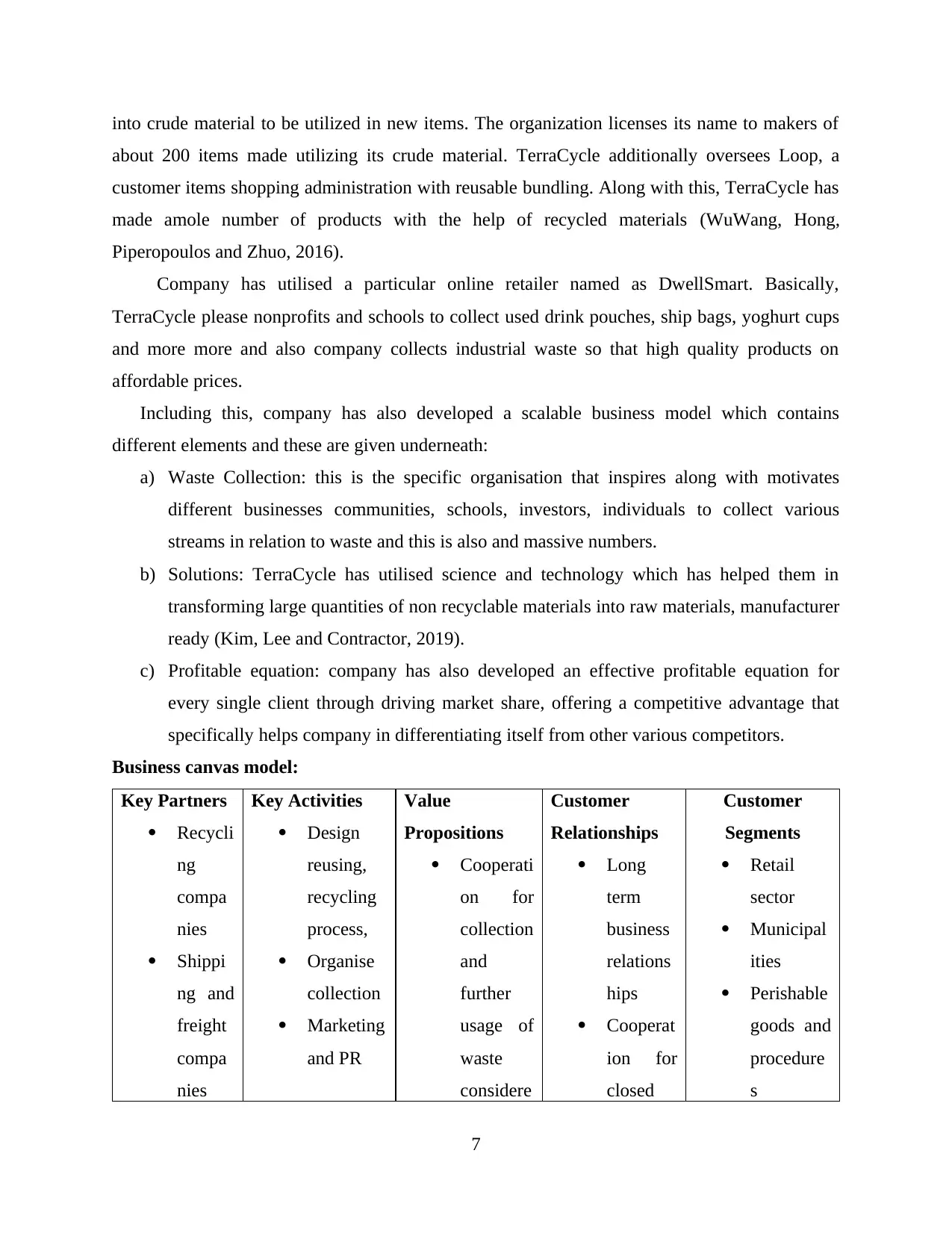
into crude material to be utilized in new items. The organization licenses its name to makers of
about 200 items made utilizing its crude material. TerraCycle additionally oversees Loop, a
customer items shopping administration with reusable bundling. Along with this, TerraCycle has
made amole number of products with the help of recycled materials (WuWang, Hong,
Piperopoulos and Zhuo, 2016).
Company has utilised a particular online retailer named as DwellSmart. Basically,
TerraCycle please nonprofits and schools to collect used drink pouches, ship bags, yoghurt cups
and more more and also company collects industrial waste so that high quality products on
affordable prices.
Including this, company has also developed a scalable business model which contains
different elements and these are given underneath:
a) Waste Collection: this is the specific organisation that inspires along with motivates
different businesses communities, schools, investors, individuals to collect various
streams in relation to waste and this is also and massive numbers.
b) Solutions: TerraCycle has utilised science and technology which has helped them in
transforming large quantities of non recyclable materials into raw materials, manufacturer
ready (Kim, Lee and Contractor, 2019).
c) Profitable equation: company has also developed an effective profitable equation for
every single client through driving market share, offering a competitive advantage that
specifically helps company in differentiating itself from other various competitors.
Business canvas model:
Key Partners
Recycli
ng
compa
nies
Shippi
ng and
freight
compa
nies
Key Activities
Design
reusing,
recycling
process,
Organise
collection
Marketing
and PR
Value
Propositions
Cooperati
on for
collection
and
further
usage of
waste
considere
Customer
Relationships
Long
term
business
relations
hips
Cooperat
ion for
closed
Customer
Segments
Retail
sector
Municipal
ities
Perishable
goods and
procedure
s
7
about 200 items made utilizing its crude material. TerraCycle additionally oversees Loop, a
customer items shopping administration with reusable bundling. Along with this, TerraCycle has
made amole number of products with the help of recycled materials (WuWang, Hong,
Piperopoulos and Zhuo, 2016).
Company has utilised a particular online retailer named as DwellSmart. Basically,
TerraCycle please nonprofits and schools to collect used drink pouches, ship bags, yoghurt cups
and more more and also company collects industrial waste so that high quality products on
affordable prices.
Including this, company has also developed a scalable business model which contains
different elements and these are given underneath:
a) Waste Collection: this is the specific organisation that inspires along with motivates
different businesses communities, schools, investors, individuals to collect various
streams in relation to waste and this is also and massive numbers.
b) Solutions: TerraCycle has utilised science and technology which has helped them in
transforming large quantities of non recyclable materials into raw materials, manufacturer
ready (Kim, Lee and Contractor, 2019).
c) Profitable equation: company has also developed an effective profitable equation for
every single client through driving market share, offering a competitive advantage that
specifically helps company in differentiating itself from other various competitors.
Business canvas model:
Key Partners
Recycli
ng
compa
nies
Shippi
ng and
freight
compa
nies
Key Activities
Design
reusing,
recycling
process,
Organise
collection
Marketing
and PR
Value
Propositions
Cooperati
on for
collection
and
further
usage of
waste
considere
Customer
Relationships
Long
term
business
relations
hips
Cooperat
ion for
closed
Customer
Segments
Retail
sector
Municipal
ities
Perishable
goods and
procedure
s
7
Paraphrase This Document
Need a fresh take? Get an instant paraphrase of this document with our AI Paraphraser
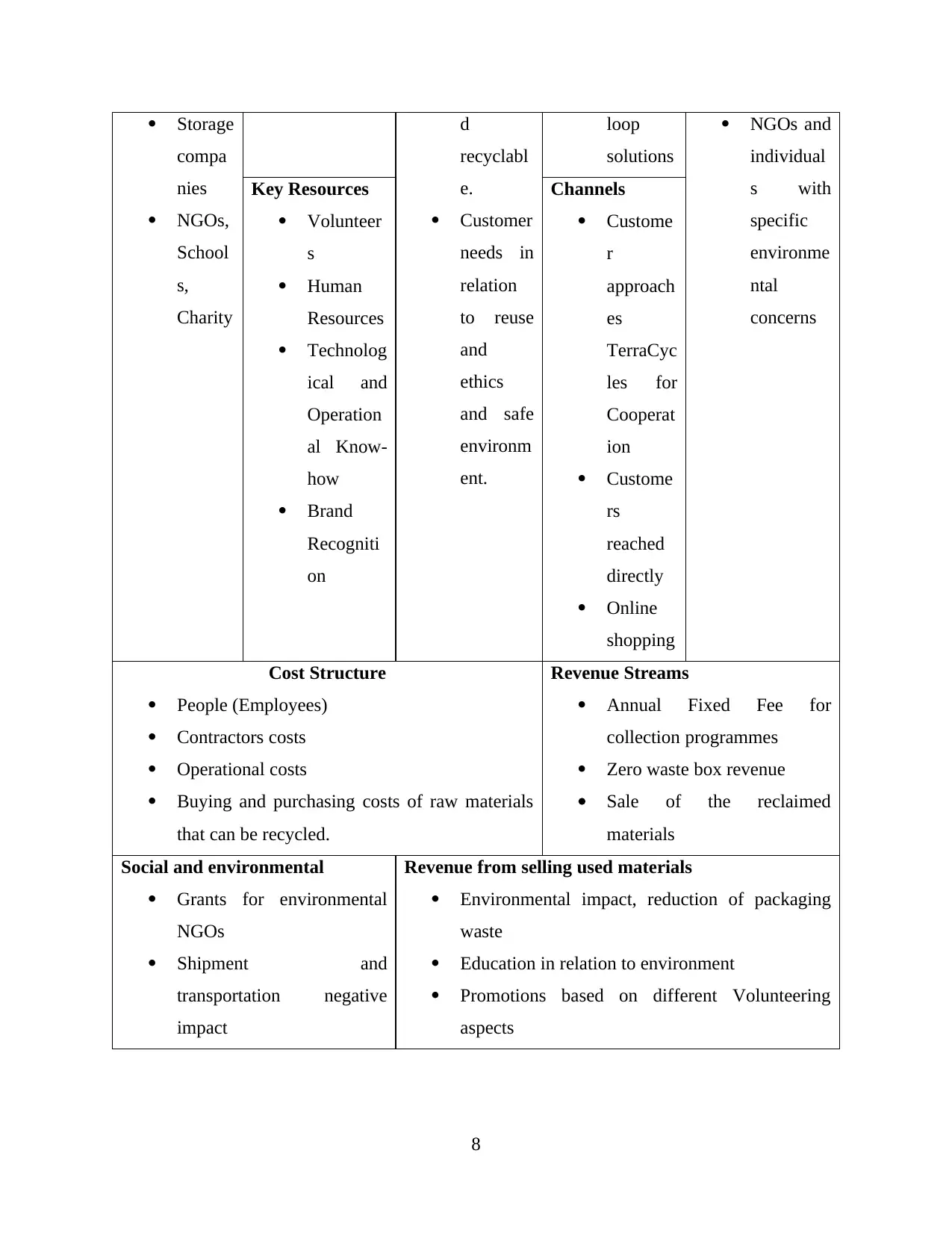
Storage
compa
nies
NGOs,
School
s,
Charity
d
recyclabl
e.
Customer
needs in
relation
to reuse
and
ethics
and safe
environm
ent.
loop
solutions
NGOs and
individual
s with
specific
environme
ntal
concerns
Key Resources
Volunteer
s
Human
Resources
Technolog
ical and
Operation
al Know-
how
Brand
Recogniti
on
Channels
Custome
r
approach
es
TerraCyc
les for
Cooperat
ion
Custome
rs
reached
directly
Online
shopping
Cost Structure
People (Employees)
Contractors costs
Operational costs
Buying and purchasing costs of raw materials
that can be recycled.
Revenue Streams
Annual Fixed Fee for
collection programmes
Zero waste box revenue
Sale of the reclaimed
materials
Social and environmental
Grants for environmental
NGOs
Shipment and
transportation negative
impact
Revenue from selling used materials
Environmental impact, reduction of packaging
waste
Education in relation to environment
Promotions based on different Volunteering
aspects
8
compa
nies
NGOs,
School
s,
Charity
d
recyclabl
e.
Customer
needs in
relation
to reuse
and
ethics
and safe
environm
ent.
loop
solutions
NGOs and
individual
s with
specific
environme
ntal
concerns
Key Resources
Volunteer
s
Human
Resources
Technolog
ical and
Operation
al Know-
how
Brand
Recogniti
on
Channels
Custome
r
approach
es
TerraCyc
les for
Cooperat
ion
Custome
rs
reached
directly
Online
shopping
Cost Structure
People (Employees)
Contractors costs
Operational costs
Buying and purchasing costs of raw materials
that can be recycled.
Revenue Streams
Annual Fixed Fee for
collection programmes
Zero waste box revenue
Sale of the reclaimed
materials
Social and environmental
Grants for environmental
NGOs
Shipment and
transportation negative
impact
Revenue from selling used materials
Environmental impact, reduction of packaging
waste
Education in relation to environment
Promotions based on different Volunteering
aspects
8
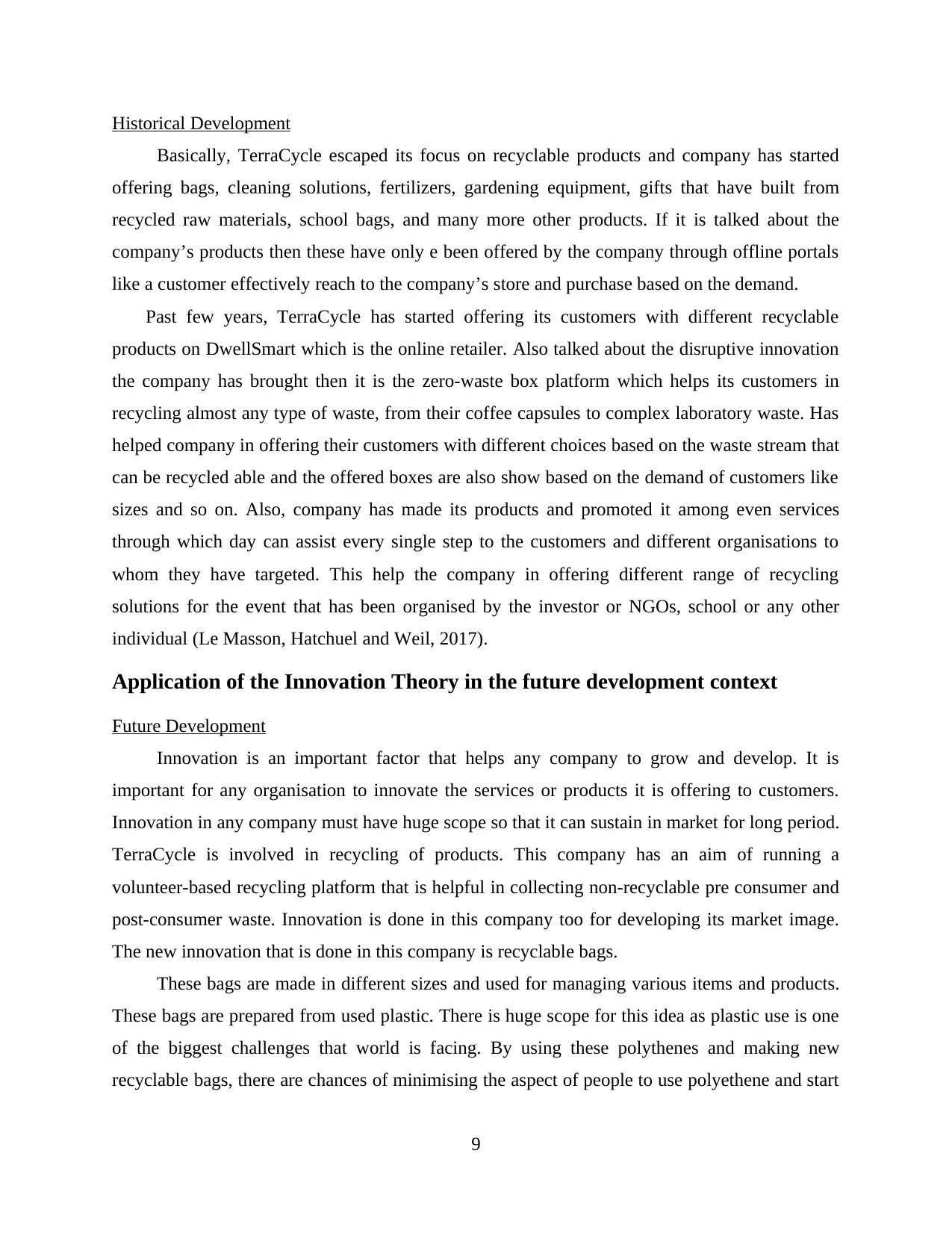
Historical Development
Basically, TerraCycle escaped its focus on recyclable products and company has started
offering bags, cleaning solutions, fertilizers, gardening equipment, gifts that have built from
recycled raw materials, school bags, and many more other products. If it is talked about the
company’s products then these have only e been offered by the company through offline portals
like a customer effectively reach to the company’s store and purchase based on the demand.
Past few years, TerraCycle has started offering its customers with different recyclable
products on DwellSmart which is the online retailer. Also talked about the disruptive innovation
the company has brought then it is the zero-waste box platform which helps its customers in
recycling almost any type of waste, from their coffee capsules to complex laboratory waste. Has
helped company in offering their customers with different choices based on the waste stream that
can be recycled able and the offered boxes are also show based on the demand of customers like
sizes and so on. Also, company has made its products and promoted it among even services
through which day can assist every single step to the customers and different organisations to
whom they have targeted. This help the company in offering different range of recycling
solutions for the event that has been organised by the investor or NGOs, school or any other
individual (Le Masson, Hatchuel and Weil, 2017).
Application of the Innovation Theory in the future development context
Future Development
Innovation is an important factor that helps any company to grow and develop. It is
important for any organisation to innovate the services or products it is offering to customers.
Innovation in any company must have huge scope so that it can sustain in market for long period.
TerraCycle is involved in recycling of products. This company has an aim of running a
volunteer-based recycling platform that is helpful in collecting non-recyclable pre consumer and
post-consumer waste. Innovation is done in this company too for developing its market image.
The new innovation that is done in this company is recyclable bags.
These bags are made in different sizes and used for managing various items and products.
These bags are prepared from used plastic. There is huge scope for this idea as plastic use is one
of the biggest challenges that world is facing. By using these polythenes and making new
recyclable bags, there are chances of minimising the aspect of people to use polyethene and start
9
Basically, TerraCycle escaped its focus on recyclable products and company has started
offering bags, cleaning solutions, fertilizers, gardening equipment, gifts that have built from
recycled raw materials, school bags, and many more other products. If it is talked about the
company’s products then these have only e been offered by the company through offline portals
like a customer effectively reach to the company’s store and purchase based on the demand.
Past few years, TerraCycle has started offering its customers with different recyclable
products on DwellSmart which is the online retailer. Also talked about the disruptive innovation
the company has brought then it is the zero-waste box platform which helps its customers in
recycling almost any type of waste, from their coffee capsules to complex laboratory waste. Has
helped company in offering their customers with different choices based on the waste stream that
can be recycled able and the offered boxes are also show based on the demand of customers like
sizes and so on. Also, company has made its products and promoted it among even services
through which day can assist every single step to the customers and different organisations to
whom they have targeted. This help the company in offering different range of recycling
solutions for the event that has been organised by the investor or NGOs, school or any other
individual (Le Masson, Hatchuel and Weil, 2017).
Application of the Innovation Theory in the future development context
Future Development
Innovation is an important factor that helps any company to grow and develop. It is
important for any organisation to innovate the services or products it is offering to customers.
Innovation in any company must have huge scope so that it can sustain in market for long period.
TerraCycle is involved in recycling of products. This company has an aim of running a
volunteer-based recycling platform that is helpful in collecting non-recyclable pre consumer and
post-consumer waste. Innovation is done in this company too for developing its market image.
The new innovation that is done in this company is recyclable bags.
These bags are made in different sizes and used for managing various items and products.
These bags are prepared from used plastic. There is huge scope for this idea as plastic use is one
of the biggest challenges that world is facing. By using these polythenes and making new
recyclable bags, there are chances of minimising the aspect of people to use polyethene and start
9
⊘ This is a preview!⊘
Do you want full access?
Subscribe today to unlock all pages.

Trusted by 1+ million students worldwide
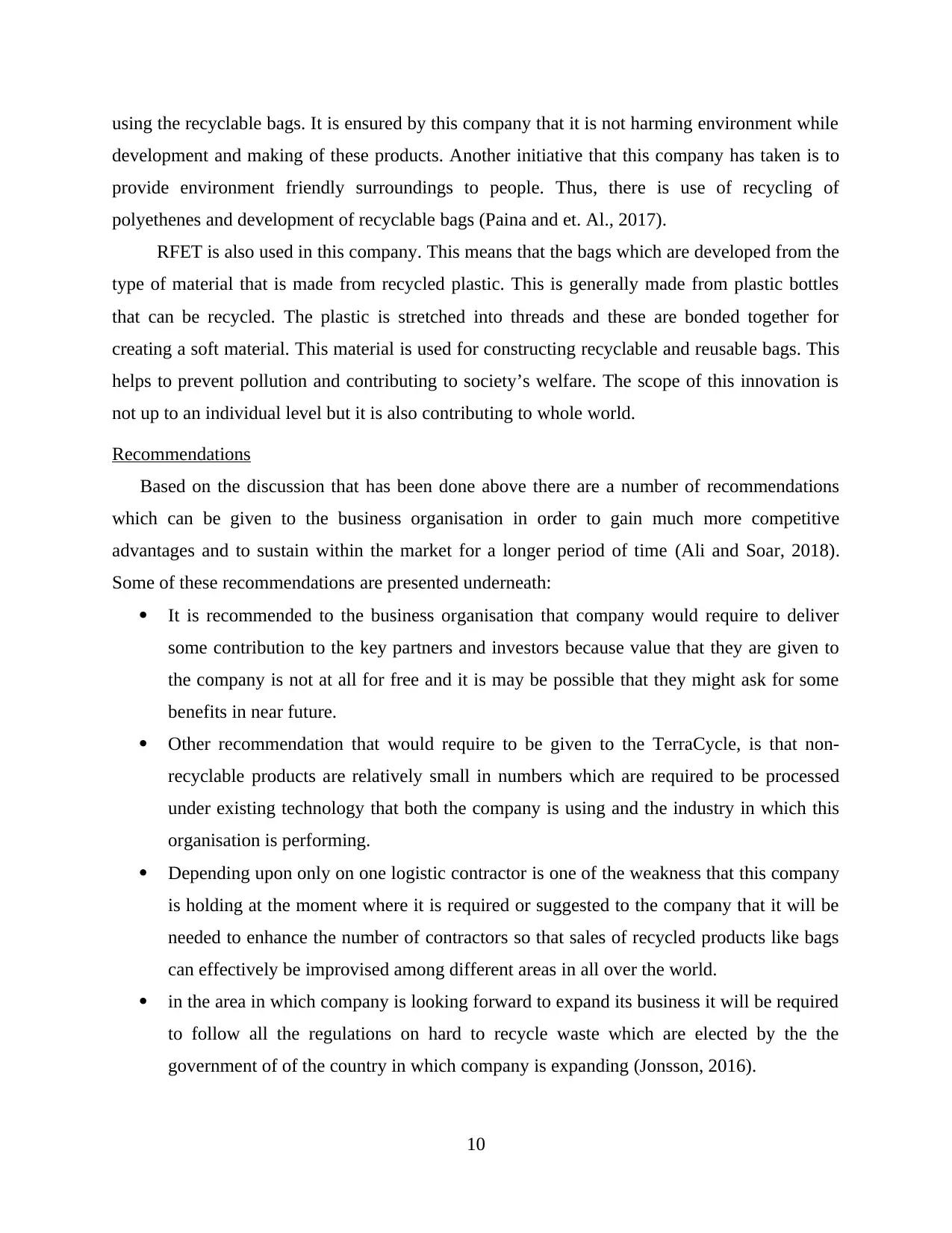
using the recyclable bags. It is ensured by this company that it is not harming environment while
development and making of these products. Another initiative that this company has taken is to
provide environment friendly surroundings to people. Thus, there is use of recycling of
polyethenes and development of recyclable bags (Paina and et. Al., 2017).
RFET is also used in this company. This means that the bags which are developed from the
type of material that is made from recycled plastic. This is generally made from plastic bottles
that can be recycled. The plastic is stretched into threads and these are bonded together for
creating a soft material. This material is used for constructing recyclable and reusable bags. This
helps to prevent pollution and contributing to society’s welfare. The scope of this innovation is
not up to an individual level but it is also contributing to whole world.
Recommendations
Based on the discussion that has been done above there are a number of recommendations
which can be given to the business organisation in order to gain much more competitive
advantages and to sustain within the market for a longer period of time (Ali and Soar, 2018).
Some of these recommendations are presented underneath:
It is recommended to the business organisation that company would require to deliver
some contribution to the key partners and investors because value that they are given to
the company is not at all for free and it is may be possible that they might ask for some
benefits in near future.
Other recommendation that would require to be given to the TerraCycle, is that non-
recyclable products are relatively small in numbers which are required to be processed
under existing technology that both the company is using and the industry in which this
organisation is performing.
Depending upon only on one logistic contractor is one of the weakness that this company
is holding at the moment where it is required or suggested to the company that it will be
needed to enhance the number of contractors so that sales of recycled products like bags
can effectively be improvised among different areas in all over the world.
in the area in which company is looking forward to expand its business it will be required
to follow all the regulations on hard to recycle waste which are elected by the the
government of of the country in which company is expanding (Jonsson, 2016).
10
development and making of these products. Another initiative that this company has taken is to
provide environment friendly surroundings to people. Thus, there is use of recycling of
polyethenes and development of recyclable bags (Paina and et. Al., 2017).
RFET is also used in this company. This means that the bags which are developed from the
type of material that is made from recycled plastic. This is generally made from plastic bottles
that can be recycled. The plastic is stretched into threads and these are bonded together for
creating a soft material. This material is used for constructing recyclable and reusable bags. This
helps to prevent pollution and contributing to society’s welfare. The scope of this innovation is
not up to an individual level but it is also contributing to whole world.
Recommendations
Based on the discussion that has been done above there are a number of recommendations
which can be given to the business organisation in order to gain much more competitive
advantages and to sustain within the market for a longer period of time (Ali and Soar, 2018).
Some of these recommendations are presented underneath:
It is recommended to the business organisation that company would require to deliver
some contribution to the key partners and investors because value that they are given to
the company is not at all for free and it is may be possible that they might ask for some
benefits in near future.
Other recommendation that would require to be given to the TerraCycle, is that non-
recyclable products are relatively small in numbers which are required to be processed
under existing technology that both the company is using and the industry in which this
organisation is performing.
Depending upon only on one logistic contractor is one of the weakness that this company
is holding at the moment where it is required or suggested to the company that it will be
needed to enhance the number of contractors so that sales of recycled products like bags
can effectively be improvised among different areas in all over the world.
in the area in which company is looking forward to expand its business it will be required
to follow all the regulations on hard to recycle waste which are elected by the the
government of of the country in which company is expanding (Jonsson, 2016).
10
Paraphrase This Document
Need a fresh take? Get an instant paraphrase of this document with our AI Paraphraser
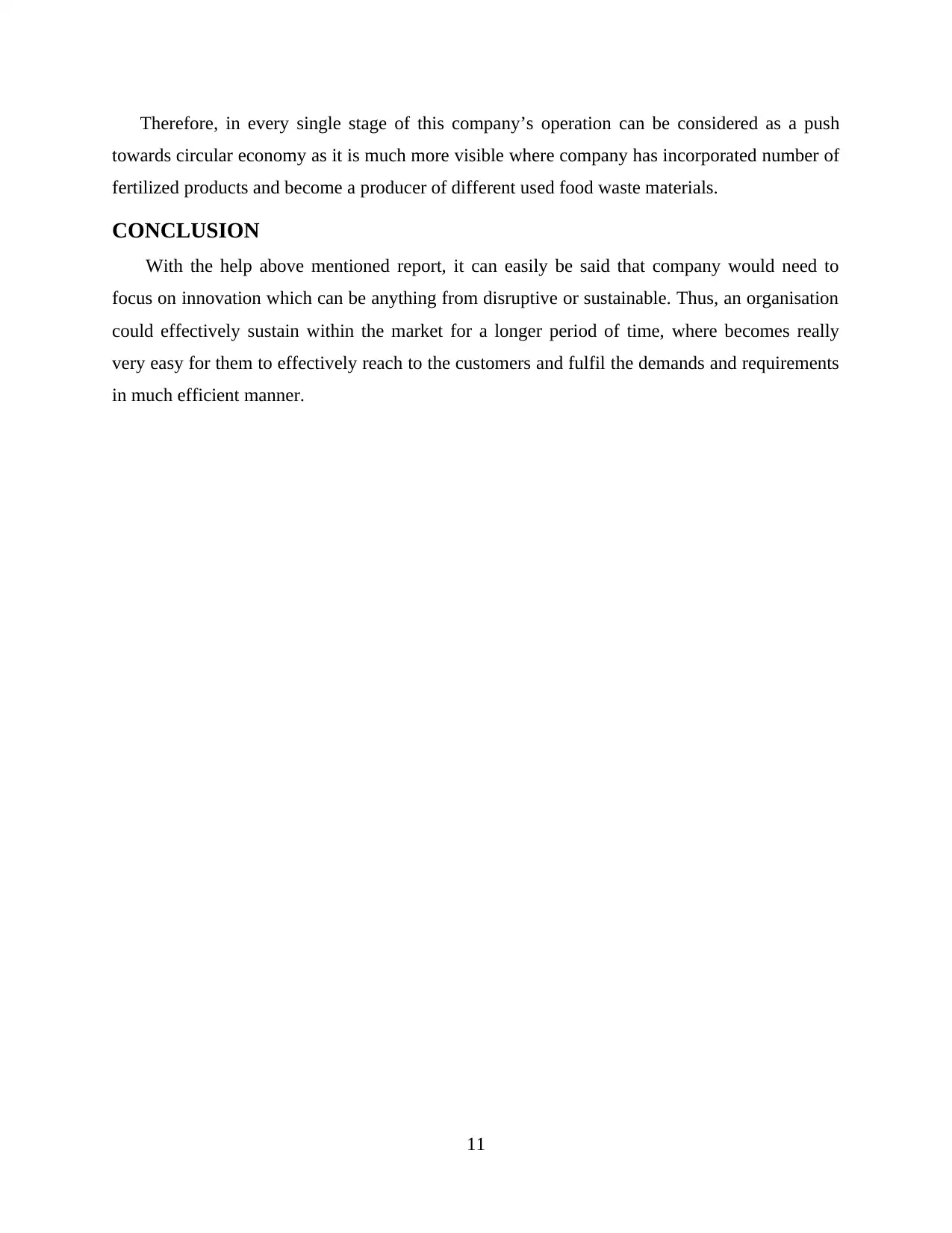
Therefore, in every single stage of this company’s operation can be considered as a push
towards circular economy as it is much more visible where company has incorporated number of
fertilized products and become a producer of different used food waste materials.
CONCLUSION
With the help above mentioned report, it can easily be said that company would need to
focus on innovation which can be anything from disruptive or sustainable. Thus, an organisation
could effectively sustain within the market for a longer period of time, where becomes really
very easy for them to effectively reach to the customers and fulfil the demands and requirements
in much efficient manner.
11
towards circular economy as it is much more visible where company has incorporated number of
fertilized products and become a producer of different used food waste materials.
CONCLUSION
With the help above mentioned report, it can easily be said that company would need to
focus on innovation which can be anything from disruptive or sustainable. Thus, an organisation
could effectively sustain within the market for a longer period of time, where becomes really
very easy for them to effectively reach to the customers and fulfil the demands and requirements
in much efficient manner.
11
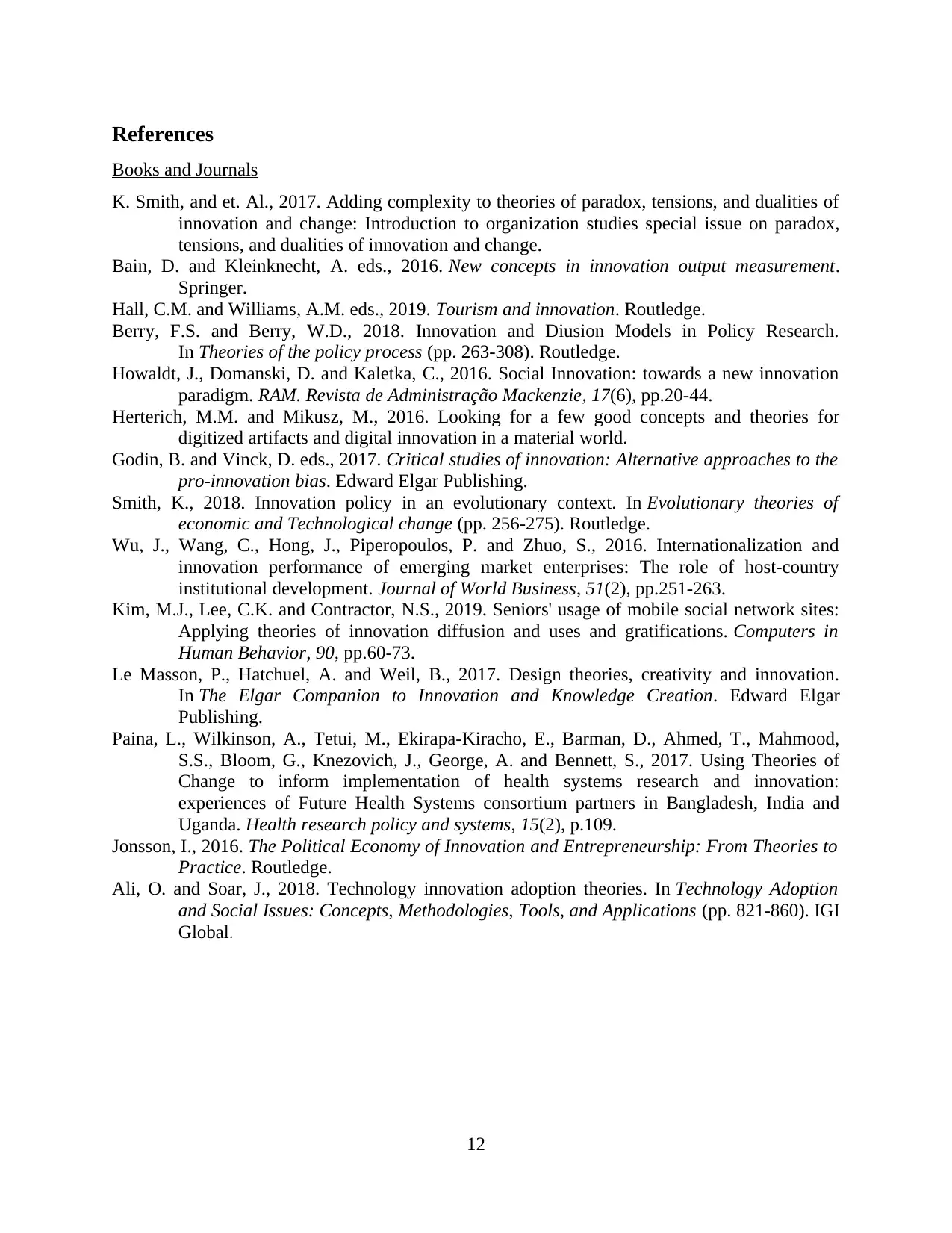
References
Books and Journals
K. Smith, and et. Al., 2017. Adding complexity to theories of paradox, tensions, and dualities of
innovation and change: Introduction to organization studies special issue on paradox,
tensions, and dualities of innovation and change.
Bain, D. and Kleinknecht, A. eds., 2016. New concepts in innovation output measurement.
Springer.
Hall, C.M. and Williams, A.M. eds., 2019. Tourism and innovation. Routledge.
Berry, F.S. and Berry, W.D., 2018. Innovation and Diusion Models in Policy Research.
In Theories of the policy process (pp. 263-308). Routledge.
Howaldt, J., Domanski, D. and Kaletka, C., 2016. Social Innovation: towards a new innovation
paradigm. RAM. Revista de Administração Mackenzie, 17(6), pp.20-44.
Herterich, M.M. and Mikusz, M., 2016. Looking for a few good concepts and theories for
digitized artifacts and digital innovation in a material world.
Godin, B. and Vinck, D. eds., 2017. Critical studies of innovation: Alternative approaches to the
pro-innovation bias. Edward Elgar Publishing.
Smith, K., 2018. Innovation policy in an evolutionary context. In Evolutionary theories of
economic and Technological change (pp. 256-275). Routledge.
Wu, J., Wang, C., Hong, J., Piperopoulos, P. and Zhuo, S., 2016. Internationalization and
innovation performance of emerging market enterprises: The role of host-country
institutional development. Journal of World Business, 51(2), pp.251-263.
Kim, M.J., Lee, C.K. and Contractor, N.S., 2019. Seniors' usage of mobile social network sites:
Applying theories of innovation diffusion and uses and gratifications. Computers in
Human Behavior, 90, pp.60-73.
Le Masson, P., Hatchuel, A. and Weil, B., 2017. Design theories, creativity and innovation.
In The Elgar Companion to Innovation and Knowledge Creation. Edward Elgar
Publishing.
Paina, L., Wilkinson, A., Tetui, M., Ekirapa-Kiracho, E., Barman, D., Ahmed, T., Mahmood,
S.S., Bloom, G., Knezovich, J., George, A. and Bennett, S., 2017. Using Theories of
Change to inform implementation of health systems research and innovation:
experiences of Future Health Systems consortium partners in Bangladesh, India and
Uganda. Health research policy and systems, 15(2), p.109.
Jonsson, I., 2016. The Political Economy of Innovation and Entrepreneurship: From Theories to
Practice. Routledge.
Ali, O. and Soar, J., 2018. Technology innovation adoption theories. In Technology Adoption
and Social Issues: Concepts, Methodologies, Tools, and Applications (pp. 821-860). IGI
Global.
12
Books and Journals
K. Smith, and et. Al., 2017. Adding complexity to theories of paradox, tensions, and dualities of
innovation and change: Introduction to organization studies special issue on paradox,
tensions, and dualities of innovation and change.
Bain, D. and Kleinknecht, A. eds., 2016. New concepts in innovation output measurement.
Springer.
Hall, C.M. and Williams, A.M. eds., 2019. Tourism and innovation. Routledge.
Berry, F.S. and Berry, W.D., 2018. Innovation and Diusion Models in Policy Research.
In Theories of the policy process (pp. 263-308). Routledge.
Howaldt, J., Domanski, D. and Kaletka, C., 2016. Social Innovation: towards a new innovation
paradigm. RAM. Revista de Administração Mackenzie, 17(6), pp.20-44.
Herterich, M.M. and Mikusz, M., 2016. Looking for a few good concepts and theories for
digitized artifacts and digital innovation in a material world.
Godin, B. and Vinck, D. eds., 2017. Critical studies of innovation: Alternative approaches to the
pro-innovation bias. Edward Elgar Publishing.
Smith, K., 2018. Innovation policy in an evolutionary context. In Evolutionary theories of
economic and Technological change (pp. 256-275). Routledge.
Wu, J., Wang, C., Hong, J., Piperopoulos, P. and Zhuo, S., 2016. Internationalization and
innovation performance of emerging market enterprises: The role of host-country
institutional development. Journal of World Business, 51(2), pp.251-263.
Kim, M.J., Lee, C.K. and Contractor, N.S., 2019. Seniors' usage of mobile social network sites:
Applying theories of innovation diffusion and uses and gratifications. Computers in
Human Behavior, 90, pp.60-73.
Le Masson, P., Hatchuel, A. and Weil, B., 2017. Design theories, creativity and innovation.
In The Elgar Companion to Innovation and Knowledge Creation. Edward Elgar
Publishing.
Paina, L., Wilkinson, A., Tetui, M., Ekirapa-Kiracho, E., Barman, D., Ahmed, T., Mahmood,
S.S., Bloom, G., Knezovich, J., George, A. and Bennett, S., 2017. Using Theories of
Change to inform implementation of health systems research and innovation:
experiences of Future Health Systems consortium partners in Bangladesh, India and
Uganda. Health research policy and systems, 15(2), p.109.
Jonsson, I., 2016. The Political Economy of Innovation and Entrepreneurship: From Theories to
Practice. Routledge.
Ali, O. and Soar, J., 2018. Technology innovation adoption theories. In Technology Adoption
and Social Issues: Concepts, Methodologies, Tools, and Applications (pp. 821-860). IGI
Global.
12
⊘ This is a preview!⊘
Do you want full access?
Subscribe today to unlock all pages.

Trusted by 1+ million students worldwide
1 out of 13
Related Documents
Your All-in-One AI-Powered Toolkit for Academic Success.
+13062052269
info@desklib.com
Available 24*7 on WhatsApp / Email
![[object Object]](/_next/static/media/star-bottom.7253800d.svg)
Unlock your academic potential
Copyright © 2020–2025 A2Z Services. All Rights Reserved. Developed and managed by ZUCOL.





